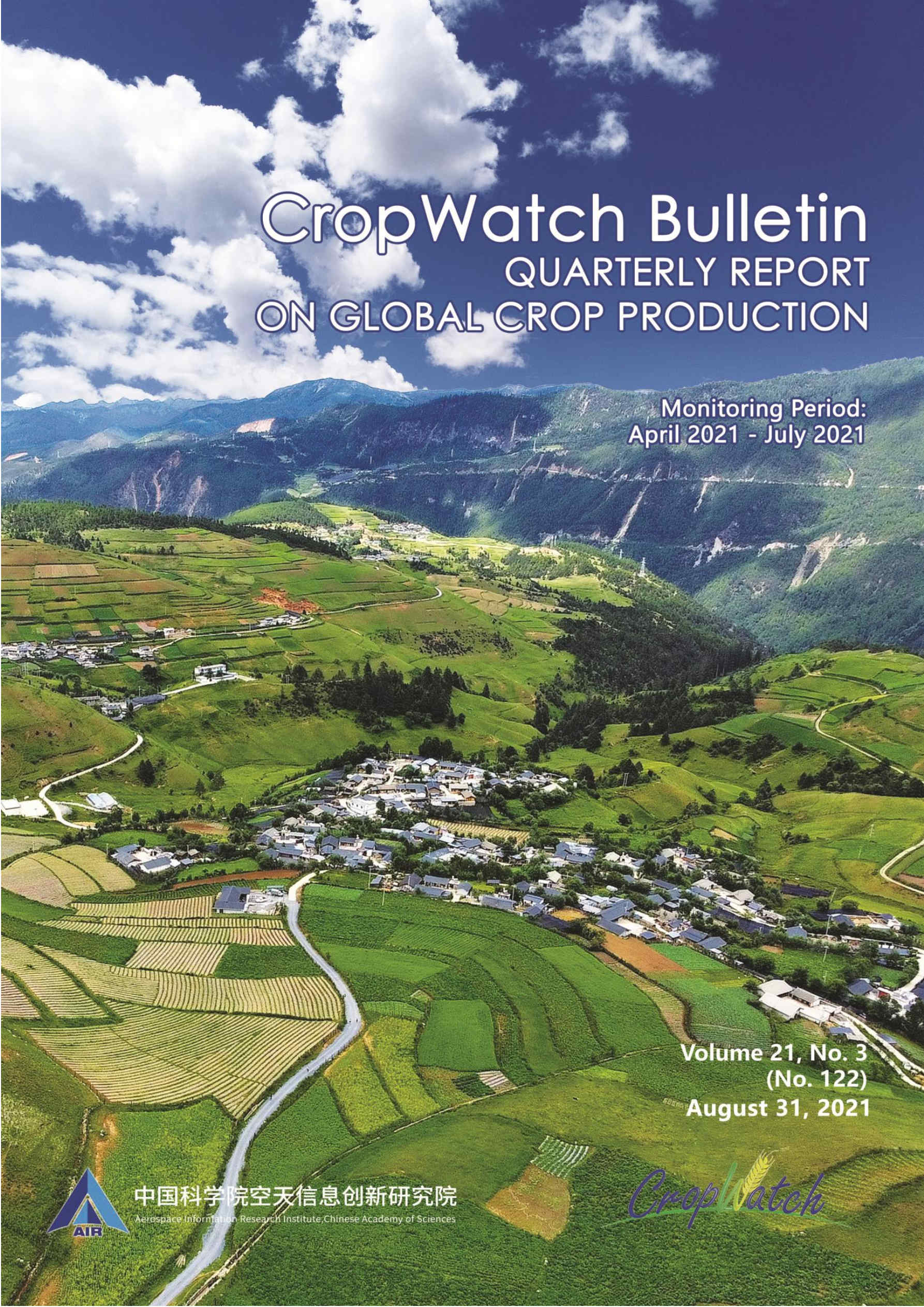
-
August 2021 CropWatch Bulletin is based mainly on current remote sensing inputs in addition to detailed and spatially accurate reference data about crops and their management. Focusing on the months of April to July 2021, chapters cover global, national, and regional level agroclimatic conditions and the condition of crops that were growing during this time. For China, the bulletin presents crop conditions for each of seven key agro-ecological zones, an updated estimate of trade prospects (import/export) of major crops. The focus section reports on the estimate by CropWatch for maize, rice, wheat and soybeans production in 2021, recent disaster events with an impact on agriculture, and the possibility of an El Niño event.
Key messages from the report:
- Widespread drought hit much of Brazil, the U.S. West Coast and southern Africa.
- Benefiting from good agroclimatic conditions, indicating a positive outlook for production in the Ukraine to Ural Mountains region, the Pampas and the Punjab to Gujarat region of South Asia.
- In 2021, the total global production of four major food crops is expected to be 2.864 billion tonnes, 1.0% above the previous year; among them, global maize production is expected to be 1.082 billion tonnes, an increase of 1.1%; global rice production is estimated at 751 million tonnes, wheat production at 711 million tonnes, and soybean production at 321 million tonnes, decreased 1.3%, 3.7% and 0.9%, respectively.
- China's total crop production in 2021 is expected to be 639 million tonnes, an increase of 1.2% from last year.
Introduction
Special attention is paid to the major producers of maize, rice, wheat and soybean throughout the bulletin. The assessment is based mainly on remotely sensed data. It covers prevailing weather conditions, including extreme factors, at different spatial scales, starting with global patterns in Chapter 1. Chapter 2 focuses on agro-climatic and agronomic conditions in major production zones in all continents. Chapter 3 covers the major agricultural countries that, together, make up at least 80% of production and exports. Each is the object of a detailed analysis. Chapter 3 constitutes the bulk of the Bulletin. Chapter 4 zooms into China. The bulletin also presents this year’s second CropWatch production estimates for selected countries and reviews the first production estimation in chapter 5. This first part of the report includes the cover, table of contents, abbreviations, a short overview of the different sections of the bulletin and executive summary.DownloadChapter 1. Global agroclimatic patterns
Chapter 1 describes the CropWatch agroclimatic indicators for rainfall (RAIN), temperature (TEMP), and radiation (RADPAR), along with the agronomic indicator for potential biomass (BIOMSS) for sixty-five global Mapping and Reporting Units (MRU). Indicator values for all MRUs are provided in Annex A.DownloadChapter 2. Crop and environmental conditions in major production zones
Chapter 2 presents the same indicators—RAIN, TEMP, RADPAR, and BIOMSS— as those used in Chapter 1, and combines them with the agronomic indicators—cropped arable land fraction (CALF), maximum vegetation condition index (VCIx), and minimum vegetation health index (VHIn)— to describe crop condition in six Major Production Zones (MPZ) across all continents. For more information about these zones and methodologies used, see the quick reference guide in Annex B.DownloadChapter 3. Main producing and exporting countries
The present section offers a closer look at individual countries, including the 42 countries that together produce and commercialize 80 percent of maize, rice, wheat, and soybean. As evidenced by the data in this section, even countries of minor agricultural or geopolitical relevance are exposed to extreme conditions and deserve mentioning, particularly when they logically fit into larger patterns.DownloadChapter 4. China
After a brief overview of the agro-climatic and agronomic conditions in China over the reporting period (section 4.1), Chapter 4 then presents China's crop prospects (section 4.2), describes the situation by region, focusing on the seven most productive agro-ecological regions of the east and south: Northeast China, Inner Mongolia, Huanghuaihai, Loess region, Lower Yangtze, Southwest China, and Southern China (section 4.3). Section 4.4 describes trade prospects of major cereals and soybean. Additional information on the agro-climatic indicators for agriculturally important Chinese provinces is listed in table A.11 in Annex A.DownloadChapter 5. Focus and perspectives
Building on the CropWatch analyses presented in chapters 1 through 4, this chapter presents food production prediction for 2021 (section 5.1), as well as sections on recent disaster events (section 5.2) and an update on El Niño or La Niña (5.3).DownloadAnnex A. Agroclimatic indicators
Tables in this Annex provide additional information about the agroclimatic indicators—RAIN, TEMP, and RADPAR—as well as BIOMSS for the various CropWatch spatial units. Those units include the Mapping and Reporting Units (MRU); the forty-three main producing and exporting countries; and regions or provinces within large countries—Argentina, Australia, Brazil, Canada, India, Kazakhstan, Russia, and the United States; and China.DownloadAnnex B. Quick reference guide to CropWatch indicators, spatial units and methodologies
Annex B presents a brief overview of the CropWatch indicators and spatial units (including the MRUs, MPZs, and countries), along with a description of the CropWatch production estimation methodology and methodology to determine the severity of the occurrence.Download

